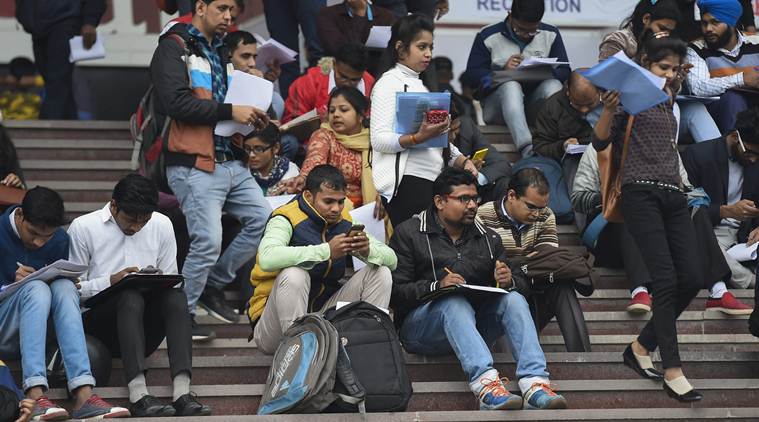Unemployment a symptom of larger failures in state policies
What is essential here, however, is that the unemployment dilemma, while worrying, is but a symptom of the larger failures in state policies that revolve around skilling and education.

Earlier this week, amidst resignations in the National Statistical Commission, the 2017-18 NSSO Labour Force survey was leaked to the media, revealing that unemployment rates were at a four-decade high. The fact that the report had been withheld by the government in an election year was subjected to heavy criticism from the Opposition and economic commentators alike, who pointed to the disastrous impact of policy decisions like demonetisation as well as the persistence of India’s “jobless growth” phenomenon.
What is essential here, however, is that the unemployment dilemma, while worrying, is but a symptom of the larger failures in state policies that revolve around skilling and education. In its latest report on budgets, post the interim Budget 2019, the Centre for Budget and Governance Accountability, clearly highlights the shrinking of the Union Government’s expenditure on education as a percentage of the budget from 4.6 per cent in 2014-15 to an abysmal 3.5 per cent in 2019-20.
The shrinking as a share of the total budget has taken place side by side with shifts in policy thinking within the sector. The shift from traditional input-oriented analysis has now given way to an outcome-driven approach. However, in its zeal to shift lenses, key supply side bottlenecks within the education sector have been overlooked.
Teacher Shortage
At present, there is a shortage of nearly five lakh teachers at the elementary level. Of the 66.41 lakh teachers, 11 lakh remain untrained. In light of its new outcome-driven approach, however, the fiscal allocation for teacher training institutions has never crossed an allocation greater than Rs 500 crore and stood at Rs 478 crore in the 2017-18 fiscal. The in-house teacher training under the Rashtriya Madhyamik Shiksha Abhiyan and Sarva Shiksha Abhiyan themselves only provide a running cost of Rs 100 and Rs 300 respectively per day, per teacher and the government’s latest push through the Samagra Shiksha Abhiyan (SMSA) for teacher training has only allocated 2 per cent of its total allocation for teacher training.
Higher Education
Significant shifts in the policy perspective adopted within higher education have led to the prioritising of the Niti Aayog’s “tiered approach” to funding and autonomy. As a by-product of this approach and the government’s penchant for supporting technical education, between 2014-15 and 2019-20, the allocation for the IIT’s has gone up by 60%, while the allocation towards State Universities and colleges that cater to the large mass of Indian students has remained low.
While the recent budget has looked to cut outlays to IIT’s and IIM’s, the massive disparity in allocation, where, till last year, 50% of the higher education funding for the 3 years prior, had gone to educating 3% of the Indian student body studying at IIT’s, IIIT’s, NIT’s and IIM’s, leaves a lot to be desired in terms of creating some semblance of allocative equity. That higher education expenditure in India is already a very small pie, is almost self-evident, but to have such grave disparities in allocation even within, ensures that the 97% of students outside of these institutions do not receive the quality education they deserve.
Skilling
In 2014, the present government established the Ministry for Skill Development and Entrepreneurship to help in achieving the extremely ambitious 2009 target of skilling 500 million people by 2022. In 2017, the government abandoned this target and switched to using a more demand oriented approach, but reiterated its aim to skill 10 million people under the Pradhan Mantri Kaushal Vikas Yojana by 2020. As of November 30, 2018, only 3.6 million people had been enrolled in the scheme, and within them only 2.6 million had received their certification, leaving the government 74% short of its own target.
Structural malaise and quick-fixes
The unemployment dilemma in India remains a by-product of a consistent structural malaise. Inadequate resource allocation and underutilisation of these limited resources year on year, has led to an overburdened public education system and an under-equipped skilling ecosystem, incapable of creating a skilled and employable labour force.
The response to this failure of the state cannot be cash hand-outs in the form of basic income or direct transfers to farmers, but in creating a substantively well-equipped labour force, and an economy that creates meaningful jobs for them to perform. As we move into an election year, it would be prudent to remember the virtue in teaching a man to fish instead of tossing him fish every time he is hungry.
(The author is a policy commentator based out of the National Law School of India University, Bangalore)






































No hay comentarios:
Publicar un comentario